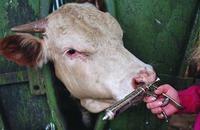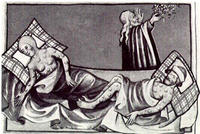-
New biofuel sources does not require farmland

While the debate over using crops for fuel continues, scientists are now reporting a new, fast approach to develop biofuel in a way that does not require removing valuable farmland from the food production chain. Their work examines the fuel-producing potential of Streptomyces, a soil bacterium known for making antibiotics.
-
-
Genes of Gypsies show traces of convergent evolution in response to Black Death
The Black Death once exterminated up to 30-50 percent of Europeans. Researchers have identified immune system genes in Europeans and Gypsies that likely underwent convergent evolution during Europe’s deadly epidemics. Immune system genes evolve under the influence of infectious diseases, but few studies have attempted genome-wide assessments of infection-driven evolution.
-
-
Oregon man infected with the plague leaves ICU
Paul Gaylord, a welder from Prineville in rural Oregon, who in July 2012 contracted bubonic plague from a stray cat, has recovered and can now reflect on his experience. After admission to the hospital, Gaylord lapsed into a coma for twenty-seven days. While in a coma, his hands and legs swelled and turned black. The doctors told him that tests showed he was infected with the bubonic plague, and that his fingers would have to be amputated.
-
-
Senegal climate change-induced flooding reaching crisis proportions: UN

Margareta Wahlstrom, the head of the UN disaster risk, last week warned that climate change-induced flooding had reached crisis proportions in Senegal, with some towns and villages now finding themselves underwater for large parts of the year. Wahlstrom, who was in Senegal for a 3-day visit as part of the UN preparations for a new global disaster risk-reduction strategy, said that mayors of coastal and riverside towns and villages told her their streets were flooded ten months out of twelve.
-
-
Chemical, physical traits of post-nuclear detonation fallout identified
Post-detonation nuclear forensics relies on advanced analytical techniques and an understanding of the physio-chemical processes associated with a nuclear detonation to identify the device type and the source of the nuclear material in the device. Researchers have begun to develop a technique that provides a practical approach for looking into the complex physical and chemical processes that occur during fallout formation following a nuclear detonation.
-
-
Antibiotic “smart bomb” targets specific strains of bacteria
Researchers have developed a de facto antibiotic “smart bomb” that can identify specific strains of bacteria and sever their DNA, eliminating the infection. The technique offers a potential approach to treat infections by multi-drug resistant bacteria.
-
-
The 9 January chemical leak in West Virginia is the latest in a long history of industrial accidents
The chemical spill that affected the water source in nine West Virginia counties in early January is part of a long history of industrial accidents resulting from the concentration of chemical and coal-mining operations in the region. The 9 January spill, which saw coal-cleansing chemical which leaked from Freedom Industries’ storage tank into the Elk River, leaving more than 300,000 residents without access to clean tap water for days, is the latest in a history of pollution which has poisoned groundwater, spewed toxic gas emissions, and caused fires and explosions.
-
-
Federal, state chemical safety agencies increasingly hampered by budget cuts
The budgets of state and federal agencies tasked with responding to the Elk River chemical spill have recently been cut, and these cuts have limited these agencies’ ability to prevent or respond to disasters such as the water crisis in West Virginia. “We do less,” said a CDC financial official, when asked the results of cuts. “What [the CDC director] has often been quoted as saying is that threats are not going down and so it is concerning to not be able to grow with the public health threats.”
-
-
Faster way to spot bacteria-tainted food -- and prevent illness
The regular appearance of food poisoning in the news, including a recent event that led to the recall of more than 33,000 pounds of chicken, drives home the need for better bacterial detection long before meats and produce make it to the dinner table.
-
-
FDA allows use of antibiotics in livestock despite “high risk” to humans

The Center for Disease Control and Prevention (CDC) has recently confirmed the link between antibiotic use on industrial farms and the rise of antibiotic resistance, saying there is “strong scientific evidence of a link between antibiotic use in food animals and antibiotic resistance in humans,” and warns of “potentially catastrophic consequences” if resistance is not slowed. The Food and Drug Administration (FDA), however, has quietly allowed thirty potentially harmful antibiotics, including eighteen rated as “high risk,” to remain on the market as additives in farm animal feed and water. The FDA first recognized the risks from the use of antibiotics in animal feed in 1977, when it proposed to withdraw approvals for animal feed containing penicillin and most tetracyclines. The agency has not followed through on its own findings – and has fought court orders to do so — and today 70 percent of all medically important antibiotics sold in the United States are sold for use in livestock production — not on humans.
-
-
New anthrax-killing virus could offer new ways to detect, treat, and decontaminate anthrax bacillus
From a zebra carcass on the plains of Namibia in Southern Africa, researchers have discovered a new, unusually large virus (or bacteriophage) which infects the bacterium that causes anthrax. The novel bacteriophage could eventually open up new ways to detect, treat, or decontaminate the anthrax bacillus and its relatives that cause food poisoning. Bacteriophages are often highly specific to a particular strain of bacteria, and when they were first discovered in the early twentieth century there was strong interest in them as antimicrobial agents. The discovery of penicillin and other antibiotics, however, eclipsed phage treatments in the West, although research continued in the Soviet Union.
-
-
Cause of one of the most devastating pandemics in human history found

An international team of scientists has discovered that two of the world’s most devastating plagues — the plague of Justinian and the Black Death, each responsible for killing as many as half the people in Europe — were caused by distinct strains of the same pathogen, one that faded out on its own, the other leading to worldwide spread and re-emergence in the late 1800s. These findings suggest a new strain of plague could emerge again in humans in the future.
-
-
Halting bugs’ crop destruction in India saves up to $309 million
Researchers who first discovered a devastating pest in India and devised a natural way to combat it have now put an economic value on their counterattack: up to $309 million the first year and more than $1 billion over five years. This is the amount of damage the papaya mealybug would have wreaked on farmers and consumers in India without scientists’ intervention. The winning intervention centered on three natural enemies of the mealybug — three parasitic wasps from Mexico— which the U.S. government first employed in Florida after the pest spread there in the late 1990s.
-
-
New strategy for controlling epidemics in big cities
Influenza places a huge burden upon society, both physically and economically. It is estimated that influenza costs the United States economy over $87 billion annually. In a large city like Washington, D.C., with about 50,000 visitors on any given day who stay for just a few days, there is a constant influx of new people who are susceptible to infections. Further, they visit highly populated tourist destinations, where they come into contact with other visitors as well as residents. Researchers, for the first time, model in detail how transient populations impact the spread of an illness, and how outbreaks such as influenza can be curbed by encouraging healthy behaviors in high-traffic tourist destinations.
-
-
Florida teenager faces bioterrorism charges
Jesse Korff, 19, of Labelle, Florida is facing federal charges in New Jersey for selling poison through a black marketplace on the underground Internet. Law enforcement says from November 2013 through 15 January this year, Korff produced, stockpiled, and sold abrin for use as a weapon. The Center for Disease Control and Prevention (CDC) considers abrin, which is extracted from the seeds of the rosary pea plant, a subset of biological agents and toxins posing a threat to public health and safety. Small doses of abrin are potentially lethal to humans if ingested, inhaled, or injected.
-
More headlines
The long view
Ransomware Attacks: Death Threats, Endangered Patients and Millions of Dollars in Damages
A ransomware attack on Change Healthcare, a company that processes 15 billion health care transactions annually and deals with 1 in 3 patient records in the United States, is continuing to cause massive disruptions nearly three weeks later. The incident, which started on February 21, has been called the “most significant cyberattack on the U.S. health care system” by the American Hospital Association. It is just the latest example of an increasing trend.
